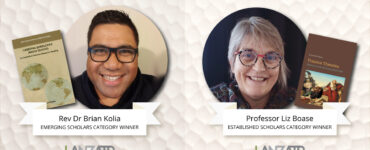The annual University of Divinity Research Day is a celebration of research efforts in theology and philosophy with over 130 participants in 2016 from the University’s eleven colleges. The significant growth in participant numbers (100 attended in 2015) was also reflected by a nearly 100% increase in the number of papers presented. In 2016, a total of 51 papers were presented throughout the day, showcasing the vibrancy and diversity of research at the University of Divinity.
The University of Divinity Research Day was held on Wednesday 1 June, at the Centre for Theology and Ministry, in Parkville.
View photos and tweets from this event.
View the full program of presentations.
You can read a sample of the abstracts from papers presented below.
ABSTRACTS
Carolyn Alsen, “The Genesis of Visual Politics: Military Drones and Ethics of Seeing”
The larger socio-political world behind the written text of the Hebrew Bible included the realities of imperial surveillance. This is of particular interest when reading Genesis narratives that describe the causes of disaster, danger and security, and considering how to read the text in a contemporary world of military and political omnividence in which everyone sees all.
Veillance, particularly as described by Steve Mann, is a visual field in which power relations are played out. Surveillance and sousveillance are watching from “above” or “below” depending on physical and political position. The Cities of the Plain in Genesis 18.16-19.29 can be considered an archetype of ancient imperial power, particularly Neo-Assyrian and Persian. Yet, these cities also function as a narrative countersign as borders, security and national identities jostle with the ethics of proximity that compels a common human response to others. The symbolic world of Genesis is an example of a political critique on the themes of mediating, maintaining or challenging the dominating tendencies of visual monitoring.
The mediated seeing that participates in a search for security is likened here to the function of military UAVs, which are mechanistic carriers of vision. The Western military industrial complex uses drone technology neither as human combatants nor as perfect electronic vigilantes. Their use is based on an interpretation of statehood and human combatants that changes territorially and according to established alliances. For example, the U.S. domestic policy regarding the use of military UAVs against “failed” states, and increasingly their own territory, is one of ‘anticipatory self-defence’ against a perceived threat to sovereignty. The problem with this is in the ways in which the warfare determines enemies or excuses ‘collateral damage’. The political ethics of military drones therefore depends largely on the use of veillance though particular interpretive frames.
The Hebrew Bible is a cultural text that represents both resistance to imperial domination for survival and the mimetic desire toward imperialism, exceptionalism and nationalistic ambitions. Reading Genesis with this in mind creates a reading experience that grapples with the covenantal politics of living in a multi-ethnic, multi-religious world. In making sense of narratives of violence, the question posed and discussed here is, does the text mimic imperial ambitions or resist colonisation through protest? Drone use illustrates the double edged nature of this postcolonial feminist question which concerns different political and faith communities that read the text.
Greg Brown, ‘Active Listening: A pastoral response from Oncology’
The data derives from the stories told by 160 cancer patients; critical reflection follows a grounded theory approach and makes the conclusion that active listening that helps the patient tell his/her story contributes to the well-being of the patient and listener alike. It is applicable to all workers engaged in pastoral and/or medical care of the patient.
Libby Byrne, ‘Practice-led Theological Inquiry: The studio as a site for theology in the making’
Whenever you pray, go into your room and shut the door… (Matthew 6:6).
In choosing to work in a particular studio an artist locates their practice somewhere on a continuum of personal and public space. Drawing on the studio experiences of Anselm Kiefer, Andy Warhol and Ai WeiWei it is possible to conceive of the studio as a home for questions and ideas, more so than an immovable place. Graeme Sullivan (2005) contends that the artist is a researcher who whose work in the studio extends the boundaries of human thought and understanding. Reflexive studio practice enables the artist researcher to pursue a question with a defined direction in mind whilst holding an open-ended, undetermined procedural trajectory (Hannula, 2004). The success of such an art-making practice is often illuminated by the degree to which the process sheds new light upon questions that have been posed and explored. With this in mind, it is possible to see how reflexive studio practice can be employed to explore a theological question.
This paper explains the development of a practice-led systematic theological inquiry into the question of healing in the absence of a cure. The paper explains how a reflexive studio practice can offer a means of engaging material and embodied knowing in the pursuit of a theological question, through the process of making, being with and seeing art. The paper argues that the 21st Century artist can work as a contemplative scholar whose engagement with theology is felt and understood through all of their senses. Offering the artwork that emerges from this form of contemplative studio practice in a public forum can be conceived as an invitation to a wider audience to be actively engaged in the process of seeing as reading. The paper considers the influence of the studio in the art-making process and goes onto explore the implications and possibilities for the artist who has been called into this room (Matthew 6:6).
Anne Elvey, ‘Feminist Ecologies in Biblical Interpretation: Elaine Wainwright and the Development of a Multidimensional Hermeneutics’
Internationally significant Australian work in ecological philosophy can be traced to at least as early as 1973 with Val and Richard Routley’s (later Val Plumwood and Richard Sylvan) Fight for the Forests. By the 1990s, Australian ecological and ecological feminist philosophy was at the forefront of international work in this area. As the 1990s came to a close, this was joined by the first major international research in ecological hermeneutics in biblical studies, The Earth Bible Project, situated in Adelaide, South Australia, under the chief editorship of Norman Habel. The Project was in conversation with feminists, ecologists and a number of indigenous peoples from Australia and overseas, as the team developed first their six ecojustice principles and then three further ecological hermeneutics. A contributor to the project, Queensland biblical scholar Elaine Wainwright, until 2014 Professor of Theology and Head of School at the University of Auckland, had previously (in 1991) published an article: ‘A Metaphorical Work through Scripture in an Ecological Age’. From early work in feminist hermeneutics, Wainwright has developed a multi-dimensional hermeneutic, bringing together feminist, ecological and postcolonial concerns, most recently around the notion of habitat. This paper traces ways in which Wainwright’s multidisciplinary approach has developed from her feminist work, and explores how her notion of habitat intersects with the new materialism. The paper points toward ways in which the notion of habitat can be developed for a twenty-first-century feminist ecological hermeneutics responsive to the complex situation of ecological destruction and (post)colonial relations to Country in Australia.
Kerrie Handasyde, ‘Divine Adventure: Methodist Fiction on the mission fields’
Methodist fiction in the early twentieth century sought to portray the adventure and romanticism of a life on the mission fields. Far from the dull predictability of suburbia, heroic ministers and missionaries led exemplary lives where drama and significance mingled in a landscape that sang to them with the voice of God. This paper examines the novels and children’s fiction of Methodist lay-preacher Edna Roughley. Her depictions of missionary life are more than fictionalised advertisements for the work of the Home Missions Department. They are invitations to write the gospel on to Queensland’s paddocks and PNG’s islands with an awareness of the complex relationship between landscape, holiness and the adventurous life.
Kris Sonek, Reading Gen 15:1 with Ancient and Modern Interpreters: Questions of Terminology and Chronology Revisited
Eminent biblical scholars write excellent commentaries, which influence generations of readers, but, occasionally, contribute to methodological confusion. This paper begins by presenting a modern debate between James Kugel and Richard Elliott Friedman on the meaning of scriptural texts. It shows that such basic terms as meaning, sense, and significance are understood differently by major scholars. The paper argues that there is an urgent need to clearly define the concepts used in biblical interpretation to make our scholarly debates mutually comprehensible and fruitful. It also suggests that we should reconsider the relationship between historical criticism and reception history by acknowledging that modern scholars do not establish the original meaning of biblical texts. Rather, they rediscover it.





